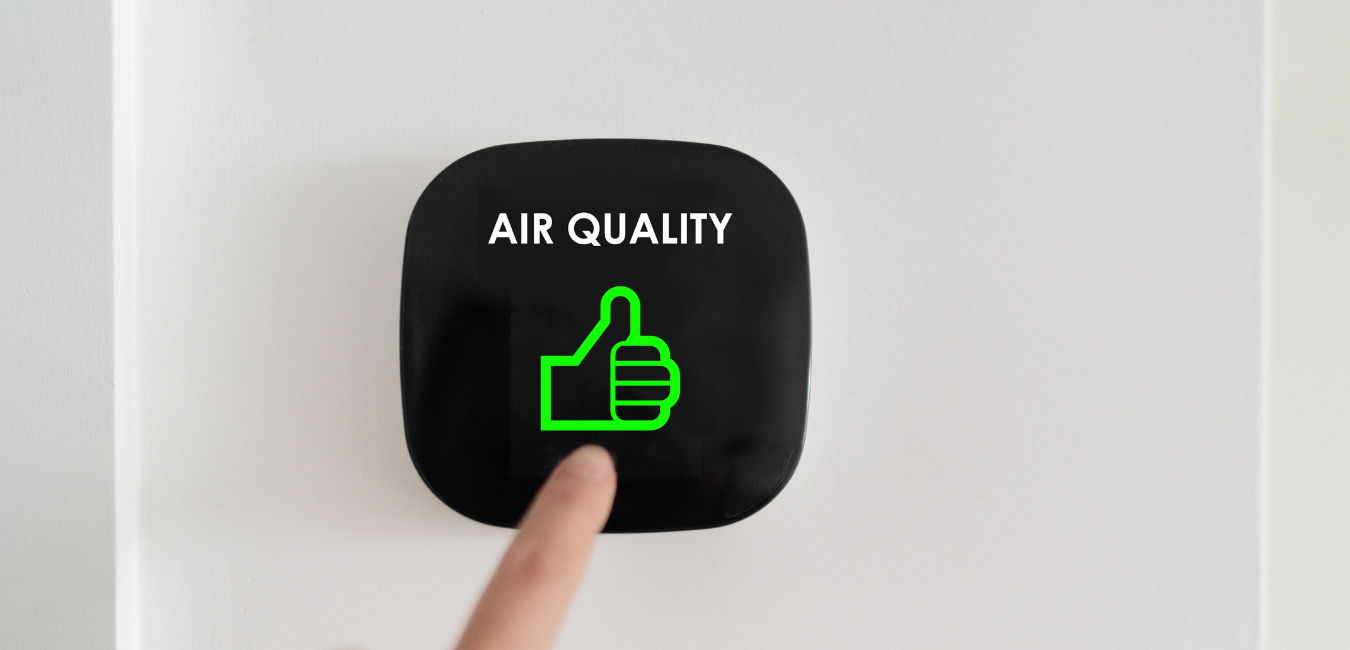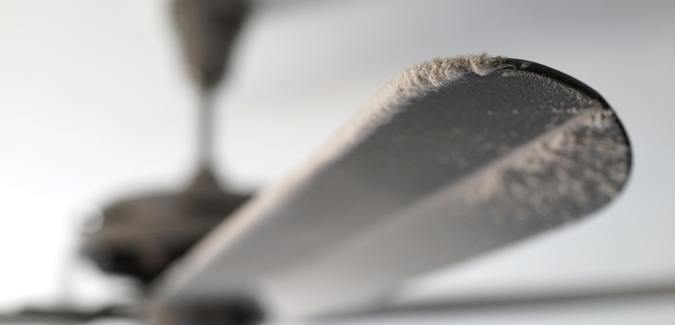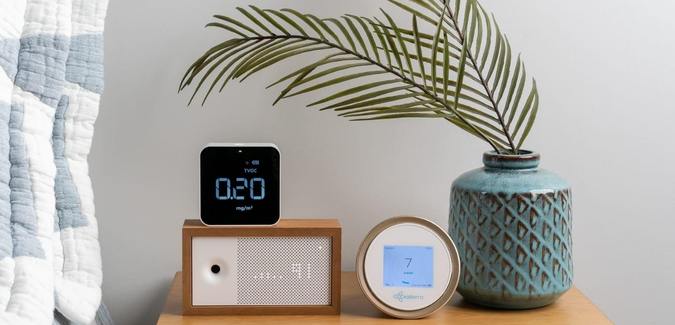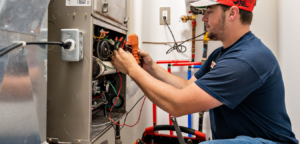
These days, we have an incredible amount of technology and many other diversions at our fingertips all the time. As a result, many of us spend more time indoors now than we ever have before. While there’s nothing inherently wrong with spending lots of time inside, it does mean that we’re frequently breathing the indoor air. So, if we want to remain healthy and comfortable, it’s especially important that we’re keeping the air in our homes as clean and healthy as possible. The more you understand indoor air quality and the variables that affect it, the better equipped you’ll be to turn your home into a haven for fresh, breathable air. Here, we’ll take a close look at what indoor air quality means, which contaminants you should be aware of, and the things you can do to improve the air that you’re regularly breathing.

Even if you’re someone who loves to get outdoors, you’re still probably spending many hours inside your home every day. That means that for hours each day, you’re breathing in whatever might be lurking in your indoor air. And if the oxygen you’re breathing is full of pollutants, it can cause a variety of adverse effects.
For example, if you suffer from allergies, certain contaminants in the air can result in many discomforts, such as a runny nose, itchy throat, and congestion. Alternatively, if you have serious respiratory issues, having contaminated air can potentially be detrimental to your physical health and well-being. These effects of poor air quality may not show up immediately, but over time, they can negatively impact your life in several ways.
Depending on where you live, the time of year, and the specifics of your household, there are quite a few different contaminants that may be found in your indoor air. Some pollutants are more harmful than others, but the majority of them can affect your health and/or comfort.

Many different types of contaminants are capable of infiltrating your home’s indoor air. If you’re aware of the most common airborne pollutants, it will give you the best chance of keeping them out of your household and dealing with them when they do arrive.
Allergens are the common contaminants that trigger symptoms in people who suffer from allergies, asthma, and other respiratory issues. A few of the most common allergens you may encounter include pollen, dust mites, and pet dander. Each type of allergen has different circumstances in which it’s most likely to appear. For example, there tends to be a lot of pollen in the air during spring, and much of it may end up in your home. Dust tends to build up in living spaces that aren’t cleaned often enough, and if you have pets, their dander will inevitably be floating around your indoor air.
Allergens in your air aren’t typically dangerous, but if left unchecked, they can cause a variety of uncomfortable symptoms—especially if you have allergies or asthma. Too many of these contaminants in your home can result in symptoms like coughing, sneezing, sore throat, runny nose, congestion, and others. While you can take medication to control these symptoms, you can also do yourself a major favor by keeping a clean house and making an effort to improve your indoor air quality.
You’ve probably heard of asbestos, but you may not know much about it. Asbestos is a naturally occurring mineral fiber that was once used frequently for a wide variety of purposes. However, once scientists realized how harmful it can be, it very quickly fell out of favor. For example, researchers discovered that exposure to asbestos can lead to asbestosis, which can result in life-threatening conditions such as lung cancer and heart failure. Unfortunately, asbestos can still be found in a variety of materials, and if you have an older home, it could be present in the construction.
Fortunately, even if there are building materials in your home containing asbestos, it’s unlikely you’ll breathe it unless you’re working directly with those materials. So, if you have an older house, it’s always wise to let professionals with the proper safety equipment handle any repairs or remodeling projects involving the construction.
Smoke can enter your home in several ways, and it always has a negative impact on your indoor air quality. If there are any cigarette smokers in your household, that secondhand smoke can pollute your air and be detrimental to your health. If you live in an area that experiences wildfires, that can also be a major source of smoke contaminating your air. If you suffer from asthma, having excessive smoke in the air may aggravate your symptoms and cause quite a bit of discomfort.
Mold is a very common fungus that can come in a variety of forms and grow on many different surfaces. The fungus typically flourishes in warm, damp places, making it extremely common in bathrooms, kitchens, and attics. If you have mold growing in your home, then there will certainly be mold spores floating around your air. A small concentration of these spores isn’t harmful, but when the spores are allowed to multiply and spread, it can begin to make your air unhealthy. That can lead to symptoms such as red eyes, sneezing, sore throat, and runny nose, among others. In addition to taking measures to improve your indoor air quality, you can reduce the chances of having mold spores in your home by keeping moisture and humidity to a minimum.
Many of us use chemicals in our day-to-day lives without giving it a second thought. In some cases, though, those chemicals can pollute our indoor air. Whether it be pesticides that you’re using for a pest problem or volatile organic compounds like those found in bleach, aerosol sprays, paint, varnish, and other household products, these chemicals are generally unhealthy for us to breathe regularly. When you use any potentially harmful chemicals in your home, it’s important that you keep the area well ventilated and avoid using more than necessary.

In some cases, it will be obvious that your indoor air quality is poor due to the physical symptoms you’re experiencing. However, it isn’t always easy to determine whether or not your home’s air is clean and healthy. And before you can start to address the issue of poor indoor air quality, you need to first be aware that the problem exists. So, how do you measure the quality of your indoor air?
One of the simplest ways to evaluate your home’s indoor air is to buy a special sensor. There are several kinds of gadgets available for detecting the presence of different contaminants in the air, such as volatile organic compounds, radon, and carbon dioxide. You can also hire your local indoor air quality professionals to visit your property and conduct an inspection. They’ll be able to evaluate your household, identify sources of air pollution, and assist you in improving your indoor air quality.
Even if you’re not sure about the quality of your indoor air, it’s always worthwhile to be proactive. The fact is, almost every household could stand to have healthier indoor air, and there are a handful of simple measures you can take to move that needle in the right direction.

If you want to ensure that the air you’re breathing is as clean and healthy as possible, there are several effective steps you can take. Whether you choose to implement all of these tips or just one of them, you’ll be making progress toward a healthier and more comfortable lifestyle for yourself and your family.
Your HVAC air filters play a major role when it comes to the overall quality of your home’s indoor air. Whenever your heating or cooling system is running, those filters are trapping airborne contaminants before they can get cycled around your living space. However, the filters eventually become dirty or clogged, which prevents them from effectively catching pollutants. This not only puts extra strain on your HVAC system, but it also leads to your indoor air quality declining significantly. To keep your air as clean as possible, you should make a point to switch your HVAC filters out regularly. Depending on the time of year and the specific type of filters you use, you should replace them every one or two months.
Although it isn’t technically a pollutant, having too much moisture in your indoor air can also lower the air quality. Not only can high humidity cause discomfort, but it can also greatly increase the chances of mold growing in your home. And if your household develops a significant mold issue, it will lead to far more mold spores floating around the air, which will further decrease the overall air quality. If you suspect that your home has a problem with high humidity, consider investing in a dehumidifier. There are many types available, and many of them give you the option to directly set your preferred humidity level for your dwelling.
One of the biggest culprits when it comes to poor indoor air quality is a lack of ventilation. If your home isn’t properly ventilated, there’s no avenue for the airborne contaminants to get circulated out of the household. As a result, the air ends up becoming stagnant, and the pollutants simply linger in the air for you and your family to consistently breathe. One simple way to improve ventilation is to regularly open a window or two around your home. This will naturally allow the air to flow more freely and carry some of the contaminants outside. You could also have one or more exhaust fans installed to ensure that any pollutants in your household are getting pushed out regularly. These fans can also help keep the humidity in check, allowing you to kill two birds with one stone.
There are several steps you can take to weatherize your home. Not only can these measures improve your indoor air quality, but they can also make it easier for your HVAC system to run smoothly and efficiently. One example is having high-quality insulation installed in your walls. This will help prevent wasted energy when running your heating and cooling systems, and it will also help prevent polluted air from entering your home from outside. You may also want to consider investing in storm windows, which will effectively seal your home against outdoor contaminants. However, if you take these weatherization steps, it will be important that you find other ways to keep your home properly ventilated. Otherwise, the air could become stagnant, which won’t do your indoor air quality any favors.
One simple thing you can do to improve your indoor air quality is to make cleaning a priority. Dust is one of the most common airborne contaminants, and it will be far more likely to accumulate if you go long periods without cleaning your living space. Every month or so, take the time to vacuum your home and wipe down hard surfaces. Additionally, take any mats and rugs outside and shake the dust, dirt, and debris from them. This shouldn’t take more than a couple of hours each month, yet it can go a long way toward keeping your indoor air nice and clean.
Another easy way to improve your indoor air quality is to invest in air purifiers for your home. Air purifiers come in many forms, and you’ll want to make sure you’re purchasing quality units. Many modern purifiers are capable of detecting contaminants in the air in real-time, then adjusting their fan speeds as necessary to trap as many of those particles as possible. If you like, you can set up several of these air purifiers around the different areas of your household. Typically, these units are fairly affordable and serve as a low-maintenance way to remove contaminants from your indoor air.
Although you may not think about your air ducts often, they have a very important role in your household. Whenever you’re running your heating or cooling system, that air must flow through your ductwork before it can warm or cool your home. Over time, though, a variety of contaminants can build up inside those ducts, including dust, dirt, and mold spores. And if the ducts are dirty, it’s inevitable that many of those pollutants will be picked up by the air as it flows through. Plus, your HVAC system has to work harder to push through the contaminants, which can affect your comfort and increase your monthly energy bills. For these reasons, it’s worth having your air ducts cleaned by professionals every couple of years. They’ll clear out all of the accumulated contaminants, and they’ll also be able to inspect for any leaks or other damage.
In addition to having your ducts cleaned regularly, it’s important to keep your household air vents consistently clean as well. After the conditioned air from your HVAC system flows through your ductwork, it must pass through the air vents before it reaches your living space. But just like the ducts, your home’s air vents are capable of accumulating various contaminants over time, which will end up in the air you’re breathing. Fortunately, cleaning your air vents is a pretty simple chore. Every month or two, visit each air vent in your home and remove the protective cover with a screwdriver. Then, using a vacuum cleaner with an extension hose, simply clear out the dust, dirt, and debris. This will go a long way toward keeping allergens out of your air and keeping the overall air quality as high as possible.
Ultraviolet light is a modern method that more and more homeowners are using to keep their indoor air clean. These special ultraviolet light air scrubbers can be installed into your existing HVAC system, and they’re capable of effectively removing airborne contaminants from your home. The great thing about these scrubbers is that they’re working 24/7 to keep your air clean, even when the air isn’t actively passing through your HVAC system. Consider asking your local indoor air quality professionals about utilizing this technology in your household.
As you can see, there’s a lot to know and keep track of when it comes to indoor air quality. For many homeowners, all of this information can be overwhelming, and that’s entirely understandable. If you have any questions or need assistance improving your home’s indoor air quality, you can always reach out to us at Flo-Aire Heating, Cooling & Electrical. Our friendly technicians are knowledgeable and experienced when it comes to air quality, and we’d be glad to evaluate your situation and help you find the most effective solutions. Give our office a call today at (734) 285-1809 if you have any questions or would like to schedule an appointment!
Locally owned and operated in Southgate, MI since 1955, Flo-Aire Heating, Cooling & Electrical is one of the top heating & cooling companies in Southeast Michigan. Flo-Aire provides residential, commercial and industrial HVAC services throughout all of Metro Detroit.


